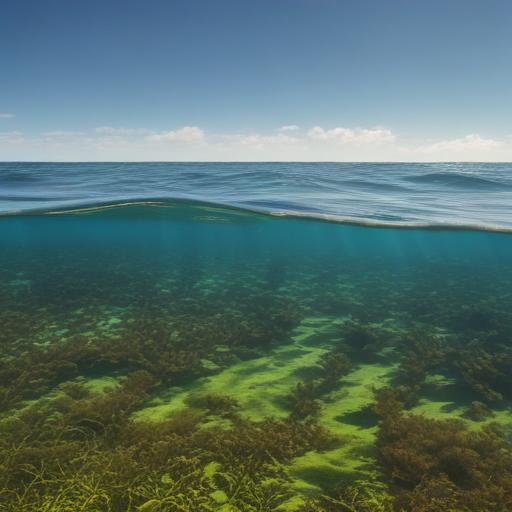A new four-decade review from researchers at Florida Atlantic University’s Harbor Branch Oceanographic Institute traces how pelagic sargassum—free-floating brown seaweed—has changed in distribution, productivity, and nutrient composition across the Atlantic, reshaping our understanding of this dynamic marine ecosystem.
The study outlines a shift from sargassum once being largely linked to the nutrient-poor waters of the Sargasso Sea to a broad, rapidly expanding bloom system known as the Great Atlantic Sargassum Belt. Since its first documented appearance in 2011, the belt has formed almost every year (except 2013), with May biomass reaching a record 37.5 million tons. This figure adds to a historical baseline biomass of about 7.3 million tons traditionally estimated for the Sargasso Sea, underscoring the belt’s exceptional scale.
Using a blend of historical oceanographic observations, modern satellite imagery, and advanced biogeochemical analyses, the authors provide a unified framework for understanding changes in sargassum distribution, productivity, and nutrient dynamics. The work highlights the broader ecological and socio-economic implications of these blooms and calls for coordinated international efforts to monitor and manage their impacts.
Key findings include:
– The GASB’s origins are tied to transport pathways from nutrient-rich coastal regions—especially the western Gulf of Mexico—into the open ocean via the Loop Current and Gulf Stream. Early satellite records in 2004 and 2005 captured windrows of sargassum in this region, where river inputs from the Mississippi and Atchafalaya contribute to nutrient loading that fuels high biomass events.
– The study notes a paradox resolved by modern observations: while the Sargasso Sea was long thought to be the primary habitat of sargassum, nutrient-enriched coastal waters and ocean circulation play a critical role in supplying material to the open Atlantic.
– Two main sargassum species, S. natans and S. fluitans, can doubling their biomass in as little as 11 days under favorable conditions. Phosphorus is often the primary limiting nutrient, with nitrogen also playing a crucial role.
– From the 1980s to the 2020s, the nitrogen content of sargassum rose by more than 50%, while phosphorus content declined slightly, driving a higher nitrogen-to-phosphorus ratio. This shift reflects a move away from natural oceanic nutrient sources toward land-based inputs such as agricultural runoff, wastewater discharges, and atmospheric deposition.
– Carbon levels in sargassum increased as well, indicating changes in stoichiometry tied to external nutrient loading and altered primary production dynamics.
– Nutrient recycling within windrows—through excretion by associated organisms and microbial breakdown—helps sustain growth even in nutrient-poor environments.
– Data from samples near the Amazon River mouth support the idea that riverine outflow contributes significantly to GASB development. Flood and drought cycles in the Amazon basin correlate with fluctuations in sargassum biomass, linking land-based nutrient flux to open-ocean dynamics.
– The belt’s formation appears to have been seeded, in part, by the negative phase of the North Atlantic Oscillation in 2009–2010, which could have helped shift surface waters and sargassum toward the tropical Atlantic. However, the authors caution that direct evidence of this movement is lacking, and some populations—such as the dominant S. natans var. wingei—may have existed in the tropical Atlantic before 2011.
– The expansion of sargassum has tangible consequences for coastal communities, including beach clogging, impacts on fisheries and tourism, and potential health risks. The study emphasizes that understanding the drivers behind this growth is crucial for managing these impacts.
The researchers highlight that the link between land-based nutrient pollution and large-scale sargassum blooms underscores the need for international collaboration to monitor, study, and respond to these phenomena. By combining satellite technology with in‑situ measurements and biogeochemical analysis, the work provides a robust framework for anticipating bloom dynamics and guiding coastal management strategies.
In this light, the review offers a hopeful take: improved monitoring and a deeper understanding of how nutrient inputs and ocean circulation drive GASB can inform proactive responses that mitigate harms to coastal economies while advancing scientific knowledge of marine nutrient cycles.
Key takeaways for readers and policymakers:
– Sargassum blooms are driven by a combination of ocean currents and nutrient inputs from land, not by a single oceanographic factor.
– Nutrient composition changes over time reflect increasing anthropogenic inputs, with nitrogen becoming relatively more available and phosphorus more limiting.
– Satellite and biogeochemical methods together are essential for tracking and understanding the blooms’ trajectory and potential impacts.
– Coordinated international monitoring and management efforts are needed to address the cross-border nature of the belt and its effects on coastal communities.
Summary: The four-decade review presents a nuanced picture of pelagic sargassum, linking dramatic biomass growth in the Atlantic to a complex interplay of natural circulation and rising land-based nutrient inputs. It highlights opportunities for better monitoring, international collaboration, and informed management to anticipate and mitigate the social and ecological impacts of this unprecedented marine phenomenon.
